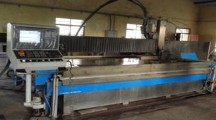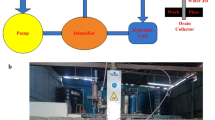Abstract
Abrasive water jet machining (AWJM) is a popular method used for cutting purposes. It uses a thin jet of ultra-high pressure water and abrasive slurry to cut the material and the cutting is mainly by erosion. The purpose of this paper is to investigate the effect of AWJM parameters on the cutting of mild steel and to optimize the process parameters. The process parameters considered for investigation are traverse speed, abrasive flow rate and standoff distance. The subsequent response parameters that have been determined are surface roughness and kerf taper angle. Taguchi L9 orthogonal array has been used to design the experiments. ANOVA is used to decide the influencing process parameters. 3D surface plots are presented for interaction effects of input process parameters. The study revealed that traverse speed is the prime factor influencing surface roughness and kerf taper angle followed by stand-off distance and abrasive flow rate. Response models are verified on the basis of estimation capability. Later on, multi-objective optimization using response surface methodology has been used for minimizing surface roughness and kerf taper angle which further resulted in composite desirability of 0.9497. The optimum values of abrasive flow rate, standoff distance and traverse speed are found to be 420 g/min, 3 mm and 85 mm/min, respectively. To validate the results, confirmation test is performed using optimum cutting parameters. It showed 9.17 and 8.57% error for surface roughness and kerf taper angle.










Similar content being viewed by others
References
Shimizu S (2011) Tribology in water jet processes. In: New tribological ways. InTech
Mutavgjic V, Jurkovic Z, Franulovic M, Sekulic M (2011) Experimental investigation of surface roughness obtained by abrasive water jet machining. In: 15th International research/expert conference “trends in the development of machinery and associated technology” TMT
Zhao W, C-w Guo, L-j Wang, F-c Wang (2017) Study on the characteristics of pressure variation in ASJ system. J Braz Soc Mech Sci Eng 39(4):1225–1232
Liu H, Wang J, Kelson N, Brown R (2004) A study of abrasive waterjet characteristics by CFD simulation. J Mater Process Technol 153:488–493
Van Luttervelt C (1989) On the selection of manufacturing methods illustrated by an overview of separation techniques for sheet materials. CIRP Ann Manuf Technol 38(2):587–607
Çaydaş U, Hasçalık A (2008) A study on surface roughness in abrasive waterjet machining process using artificial neural networks and regression analysis method. J Mater Process Technol 202(1):574–582
Sharma VS, Dhiman S, Sehgal R, Sharma S (2008) Estimation of cutting forces and surface roughness for hard turning using neural networks. J Intell Manuf 19(4):473–483
Öktem H (2009) An integrated study of surface roughness for modelling and optimization of cutting parameters during end milling operation. Int J Adv Manuf Technol 43(9–10):852–861
Sheikh-Ahmad JY (2009) Machining of polymer composites. Springer, New York
Wang J, Kuriyagawa T, Huang C (2003) An experimental study to enhance the cutting performance in abrasive waterjet machining. Mach Sci Technol 7(2):191–207
Rao MS, Ravinder S, Kumar AS (2014) Parametric optimization of abrasive water jet machining for mild steel: Taguchi approach. Int J Curr Eng and Technol Special Issue 2:28–30
Begic-Hajdarevic D, Cekic A, Mehmedovic M, Djelmic A (2015) Experimental study on surface roughness in abrasive water jet cutting. Procedia Eng 100:394–399
Aultrin KJ, Anand MD (2014) Experimental framework and study of AWJM process for an aluminium 6061 alloy using RSM. In: Control, instrumentation, communication and computational technologies (ICCICCT), 2014 international conference on, 2014. IEEE, pp 1432–1440
Santhanakumar M, Adalarasan R, Rajmohan M (2015) Experimental modelling and analysis in abrasive waterjet cutting of ceramic tiles using grey-based response surface methodology. Arab J Sci Eng 40(11):3299–3311
Nair A, Kumanan S (2018) Optimization of size and form characteristics using multi-objective grey analysis in abrasive water jet drilling of Inconel 617. J Braz Soc Mech Sci Eng 40(3):121
Hascalik A, Çaydaş U, Gürün H (2007) Effect of traverse speed on abrasive waterjet machining of Ti–6Al–4 V alloy. Mater Des 28(6):1953–1957
Naresh Babu M, Muthukrishnan N (2014) Investigation on surface roughness in abrasive water-jet machining by the response surface method. Mater Manuf Process 29(11–12):1422–1428
Kumar A, Singh H, Kumar V (2017) Study the parametric effect of abrasive water jet machining on surface roughness of Inconel 718 using RSM-BBD techniques. Mater Manuf Process 1–8
Azmir M, Ahsan A (2009) A study of abrasive water jet machining process on glass/epoxy composite laminate. J Mater Process Technol 209(20):6168–6173
Armağan M, Arici AA (2017) Cutting performance of glass-vinyl ester composite by abrasive water jet. Mater Manuf Process 32(15):1715–1722
Bhowmik S, Ray A (2015) Prediction of surface roughness quality of green abrasive water jet machining: a soft computing approach. J Intell Manuf 1–15. https://doi.org/10.1007/s10845-015-1169-7
Khan AA, Haque M (2007) Performance of different abrasive materials during abrasive water jet machining of glass. J Mater Process Technol 191(1):404–407
Hocheng H, Chang K (1994) Material removal analysis in abrasive waterjet cutting of ceramic plates. J Mater Process Technol 40(3–4):287–304
Gupta V, Pandey P, Garg MP, Khanna R, Batra N (2014) Minimization of kerf taper angle and kerf width using Taguchi’s method in abrasive water jet machining of marble. Procedia Mater Sci 6:140–149
Nair VN, Abraham B, MacKay J, Box G, Kacker RN, Lorenzen TJ, Lucas JM, Myers RH, Vining GG, Nelder JA (1992) Taguchi’s parameter design: a panel discussion. Technometrics 34(2):127–161
Rao TB, Krishna AG, Katta RK, Krishna KR (2015) Modeling and multi-response optimization of machining performance while turning hardened steel with self-propelled rotary tool. Adv Manuf 3(1):84–95
Lin C (2004) Use of the Taguchi method and grey relational analysis to optimize turning operations with multiple performance characteristics. Mater Manuf Processes 19(2):209–220
Jain VK (2009) Advanced machining processes. Allied publishers
Gupta V, Garg M, Batra N, Khanna R (2013) Analysis of kerf taper angle in abrasive water jet cutting of Makrana white marble. Asian J Eng Appl Technol ISSN:35-39
Myers RH, Montgomery DC, Anderson-Cook CM (2016) Response surface methodology: process and product optimization using designed experiments. Wiley, New York
Deshpande YV, Andhare AB, Padole PM (2018) Experimental results on the performance of cryogenic treatment of tool and minimum quantity lubrication for machinability improvement in the turning of Inconel 718. J Braz Soc Mech Sci Eng 40(1):6
John MS, Balaji B, Vinayagam B (2017) Optimisation of internal roller burnishing process in CNC machining center using response surface methodology. J Braz Soc Mech Sci Eng 39(10):4045–4057
Rao KV, Murthy P (2016) Modeling and optimization of tool vibration and surface roughness in boring of steel using RSM, ANN and SVM. J Intell Manuf 1–11
Deshpande Y, Andhare A, Sahu NK (2017) Estimation of surface roughness using cutting parameters, force, sound, and vibration in turning of Inconel 718. J Braz Soc Mech Sci Eng 1–10
Sreekesh K, Govindan P (2013) Experimental Investigation and analysis of abrasive water-jet machining process. In: Proceedings of the international conference on advancements and futuristic trends in mechanical and materials engineering, pp 472-477
Bhowmik S, Ray A (2017) Abrasive water jet machining of composite materials. In: Advanced manufacturing technologies. Springer, pp 77–97
Ghodsiyeh D, Golshan A, Izman S (2014) Multi-objective process optimization of wire electrical discharge machining based on response surface methodology. J Braz Soc Mech Sci Eng 36(2):301–313
Deshpande Y, Andhare A, Padole P, Sahu N (2018) Application of advanced algorithms for enhancement in machining performance of Inconel 718. Indian J Eng Mater Sci (in press)
Author information
Authors and Affiliations
Corresponding author
Additional information
Technical Editor: Márcio Bacci da Silva.
Rights and permissions
About this article
Cite this article
A. Dumbhare, P., Dubey, S., V. Deshpande, Y. et al. Modelling and multi-objective optimization of surface roughness and kerf taper angle in abrasive water jet machining of steel. J Braz. Soc. Mech. Sci. Eng. 40, 259 (2018). https://doi.org/10.1007/s40430-018-1186-5
Received:
Accepted:
Published:
DOI: https://doi.org/10.1007/s40430-018-1186-5




